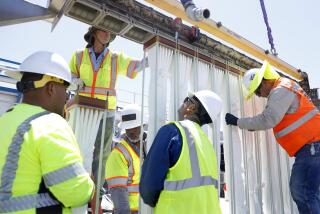Trump administration unveils major Clean Water Act rollback

The Trump administration unveiled its plan Tuesday for a major rollback of the Clean Water Act, a blueprint drawn up at the behest of farm groups, real estate developers and other business interests that would end federal protections on thousands of miles of streams and wetlands.
The proposal has big implications for California and other arid Western states, where many of the seasonal streams and wetlands that are a foundation of drinking-water supplies and sensitive ecosystems would lose federal protection.
Acting Environmental Protection Agency Administrator Andrew Wheeler said the Obama-era rule that put those waters under the protection of the Clean Water Act “further expanded Washington’s reach into privately owned lands.”
“They claimed it was in the interest of water quality, but it was really about power,” Wheeler said. “Power in the hands of the federal government over landowners.”
Studies conducted by the Obama-era EPA suggest that as many as two-thirds of California’s inland freshwater streams fall into categories that would be at risk of losing protection under the Trump administration plan. Wheeler dismissed those studies as scientifically flawed, but his agency said it could not offer an accurate estimate of how much federal protection would be diminished in the state.
“California already has water protections in place that are stricter than the federal government’s, so nothing is going to change for the California waters,” he said.
Former EPA regulators drew a starkly contrasting picture, saying state agencies do not have the resources or expertise to backfill all the work the EPA would stop doing under Trump’s proposed rule.
“The ramifications could be huge,” said Jessica Kao, who earlier this year left her position as the EPA’s lead Clean Water Act enforcement attorney in the Southwest.
“You will definitely see more development projects outside the purview of the Clean Water Act.”
The latest look at the Trump administration and the rest of Washington »
The new rules would enable many polluting projects to skirt federal environmental reviews and allow companies building everything from oil pipelines to residential subdivisions to avoid warning the public of potential water-quality hazards they create, she said.
“It will be easier to pollute and fill these streams,” she said. “And years later, we will deal with the consequences.”
The proposal, which now moves into a 60-day public comment period, is certain to draw legal challenges from environmental groups and many states.
The fight marks the latest chapter in a decades-long struggle over the reach of the Clean Water Act. Agriculture businesses, developers and oil and mining companies say the existing rule has enabled heavy-handed bureaucrats to impose hefty fines on them for disrupting ditches and filling wetlands never meant to be regulated by the federal government.
Farm groups also worry that strict clean water regulations will limit their ability to use pesticides and fertilizers on fields that could drain into creeks and swamps.
The Obama EPA investigated those concerns while drafting the existing rule and found them to be lacking merit. It reviewed hundreds of studies in concluding that enforcing the protections widely on wetlands and seasonal streams would provide hundreds of millions of dollars in benefits to the national economy. The Trump administration’s proposal disputes those benefits, concluding any economic boost to be gained from the Obama-era rule is eclipsed by its costs to landowners and business.
“I don’t know there is one single rule that has caused as much concern and frustration,” said Sen. Lisa Murkowski (R-Alaska). “You needed this army of hydrologists and engineers and lawyers just to figure out whether your project could even begin.”
Many states, particularly those with Republican governments, had joined industry in fighting the Obama-era rules, calling them an unwelcome and unnecessary intrusion.
Wheeler quoted a finding from the Missouri Farm Bureau that 95% of the land in that state could contain water subject to the Obama-era rule, which Wheeler said “put local land-use decisions in the hands of distant, unelected bureaucrats.”
Other states, including California, have backed the Obama EPA’s rules.
California Atty. Gen. Xavier Becerra repeated the state’s position Tuesday, saying in a message on Twitter that the state would “defend CA’s right to clean drinking water and pollution-free streams and lakes.”
The Supreme Court has struggled to define which waters should be protected under the Clean Water Act. A 2006 case resulted in multiple opinions.
The Obama administration crafted its rule around the definition of protected waters offered up by Justice Anthony M. Kennedy, who recently retired. But President Trump, within a month of taking office, ordered his administration to embrace the far more narrow definition the late Justice Antonin Scalia provided in his opinion.
While the administration plan faces a tough legal fight, the Supreme Court’s shift in a more conservative direction since the Clean Water Act was last heard there could give Trump and his aides an edge.
“It may very well be upheld if the administration does a good job of substantiating its approach,” said an email from Ann Navaro, a former chief counsel of litigation at the Army Corps of Engineers.
But the court is often loath to overturn precedent, and many lower courts have already embraced the Kennedy opinion from a decade ago. Attorneys for environmental groups are hopeful that the scale of the administration’s planned rollback will ultimately sink it in litigation.
“They want to shrink the jurisdiction of the Clean Water Act to a level we have not seen in decades,” said Blan Holman, managing attorney at the Southern Environmental Law Center. “They say they are doing something that is consistent with the Supreme Court’s earlier ruling, but it is not.”
More stories from Evan Halper »
evan.halper@latimes.com | Twitter: @evanhalper
More to Read
Get the L.A. Times Politics newsletter
Deeply reported insights into legislation, politics and policy from Sacramento, Washington and beyond. In your inbox three times per week.
You may occasionally receive promotional content from the Los Angeles Times.







